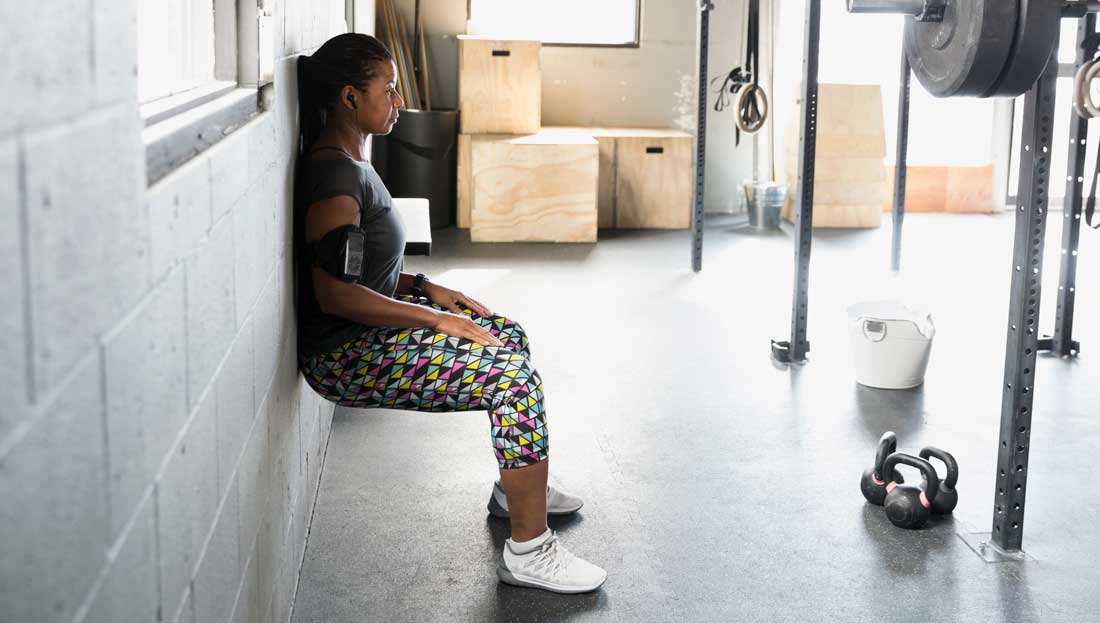
When Ginny Stephan gave birth to her fourth child 12 years ago, she didn’t expect so many problems afterward. Her first delivery was a cesarean section (C-section) and the next two were vaginal (vaginal birth after cesarean or VBAC). She didn’t note any lasting problems following her deliveries, until the fourth, at which time, she says, “Everything went south.”
Since then Stephan has gone to physical therapy for pelvic floor and core strengthening, and is now looking to return to therapy to train her bladder. “I can’t run or jump at all without leakage, and my abdominal muscles are still struggling to get back into shape,” she explains.
While Stephan says physical therapy helped some, it wasn’t enough at the time. “The next step is bladder exercises to train my bladder to ‘go’ at certain times of the day.”
In the 12 years since Stephan’s experience, much has been discovered regarding the issues that may arise following a C-section. Once your clients are ready to come back to training with you post-cesarean, having a great understanding about this procedure and how it affects the body can enable you to play an important role in their post-natal fitness plan.
C-Section Basics
Because C-sections are common—the latest stats from the Centers for Disease Control and Prevention (CDC) estimate that 31.9% of all babies in the U.S. are delivered via C-section—it’s easy to forget the fact that they are a serious procedure. Not only has the mother gone through nine months of pregnancy, but she now has to deal with giving birth, healing from surgery and taking care of a newborn all at once.
“Let me emphasize that a cesarean section is major abdominal surgery,” urges Joanne Donoghue, Ph.D., A.C.S.M.-R.C.E.P., director of clinical research and assistant professor of osteopathic manipulative medicine at the New York Institute of Technology College of Osteopathic Medicine in Long Island. “The abdominal wall has been stretched for nine months while working to support the body’s extra weight. Then it is cut, stretched so that organs can be shifted, and the uterus is then cut to deliver the baby. After that trauma, everything is stitched back together.”
It’s important to note that the muscles of the abdomen are not typically cut. “In most cases with a C-section, no muscles are cut, which is great,” explains Reema Thakkar, P.T., D.P.T., director of clinical education and assistant professor at Touro College School of Health Sciences in Manhattan. “The C-section incision is [usually] made horizontally, just above the pubic bone, and the abdominal muscles are moved apart in order to reach the uterus.”
Add to this the natural consequences from relaxin, the hormone that is produced by the pregnant body. While its specific purpose is to relax the joints of the pelvis, it creates laxity in all the joints of the body.
“During pregnancy, your body goes through a natural relaxing and stretching regimen to make room for the baby and uterus with the help of relaxin,” adds Thakkar. “While this is great for your new bundle of joy, it can often take a toll on your joints that are working overtime with the extra weight and the lack of stability from the ligaments and muscles all around.”
Regardless of the method of delivery, postpartum women need to ease back into exercise; women post-cesarean section, however, have an added challenge in that their recovery period is often considerably longer than that of a woman who experienced a vaginal delivery.
A recent study published in Medicine & Science in Sports & Exercise highlights the differences between women who had never been pregnant (the control group) and those who experience either a C-section or vaginal delivery. The researchers found that all the postpartum women in the study, regardless of the method of delivery, were weaker at all trunk angles at both eight and 26 weeks when compared to the control group. The muscles of the postpartum women also fatigued more quickly compared to the control group. However, women who delivered via C-section had one distinct difference: They were 59% more fatigable at eight weeks compared to the vaginal delivery group.
Where Do You, the Fit Pro, Come In?
Prenatal fitness has undergone a transformation over the past few decades. Gone are the restrictive activity guidelines that severely limited healthy women with low-risk pregnancies. Whether or not your postpartum clients were able to exercise during pregnancy, a gradual progression should be followed to allow time for the postpartum body to ease into its new normal.
As with any other condition, be sure to receive approval from your client’s healthcare provider before starting to work with her during the postpartum period.
“Once cleared by her O.B., I would begin by making sure that she has no pain at the healing site,” advises Thakkar. “A good way to do this is to have her lie on her back with one knee bent and raise the other leg up about one inch to see if she feels pain at the site. Keep in mind that ‘tugging’ is not pain. She may feel a mild tug in that area, and that’s O.K. Any pain felt should be reported to her O.B. prior to beginning an exercise program.”
When it comes to core work, begin with core exercises that focus on isometric strengthening of the transverse abdominis (TVA), which is the deepest abdominal muscle, advises Leah Keller, founder of Every Mother and creator of the EMbody program. “This muscle engagement should always be paired with an exhalation to avoid increasing intra-abdominal pressure. It is very important to establish baseline strength, control and integrity of the abdominal wall with isometric strengthening prior to performing more challenging core stabilization exercises, such as full planks.”
Keller emphasizes the importance of performing TVA contractions properly. “The contraction of the TVA must always be in a concave direction—navel toward the spine—never in a bracing, barreling or flexing contraction that exerts outward pressure on the abdominal wall,” says Keller. Additionally, “the client should never feel like she is bracing the abs for a punch, bearing down on the pelvic floor, or tensing the muscle with such intensity that she cannot control the direction of movement. She should avoid any exertion that barrels or bulges the abdominal wall forward or the pelvic floor downward. Effective, therapeutic activation of the TVA must always be a controlled engagement toward the spine and combined with both an exhalation and a lifting squeeze of the pelvic floor—with the exception of those with pelvic floor hypertonicity.”
Note: Signs of pelvic floor hypertonicity include chronic constipation, tailbone pain and pain during intercourse. Women with any of these signs should be referred to a physical therapist for further evaluation, as pelvic floor strengthening may not be recommended for them. It is worth noting that a recent study showed that postnatal exercise may reverse diastasis recti when performed properly.
Offer your postpartum clients the following protocol so they can practice TVA/core contractions:
- Lie supine with knees bent, feet on the floor, with your hands on your abdomen.
- Inhale, allowing your abdomen to rise and “fill with air.”
- Exhale as you pull your abdominal muscles in toward your spine.
- While maintaining this abdominal position, take smaller inhalations, quickly exhaling and pulling the abdominal muscles toward the spine with each exhalation. Repeat for up to two minutes, performing this exercise for a total of about 10 minutes a day (accumulated over several “sessions” per day).
- Once the basic technique is mastered, urge your clients to practice it in other positions: sitting, standing and on all fours.
At approximately eight to 10 weeks postpartum, with clearance from their medical provider/OB, you can begin to increase the difficulty of your client’s exercises. “A great place to start,” suggests Thakkar, “is by engaging the adductors while performing your [pelvic floor exercises]. Place a ball or pillow between your legs. When you [pull the pelvic floor muscles up] simultaneously squeeze the ball. Once you’ve mastered this, you can add a bridge.”
Thakkar also likes wall squats with the adductor ball squeeze. “These are great, because hip extension and gluteal strength are keys to helping diastasis. This is due to a change in mechanics in the last trimester, which causes excessive abdominal pull. Pelvic tilts in standing help reorient the spine and work with the transverse abdominis in diastasis.”
Use Caution
Many exercises are just too advanced and intense and should be avoided during the first 10 to 12 weeks following a C-section. According to Donoghue, these include crunches, sit-ups, leg raises, planks, running, jumping, step-ups, overhead presses and heavily weighted exercises.
“Heavy lifting is an absolute contraindication until cleared by her physician,” urges Thakkar, “but consider lifting nothing heavier than the baby for three to four months.”
“Your client should be making steady, measurable progress in core strength and integrity,” advises Keller. “I typically gather abdominal circumference measurements every three weeks with postpartum clients. They consistently show improvements in both abdominal circumference and waist circumference. They should also experience relief of back pain, steady improvements in pelvic floor function in that they have less or no urine leakage, improved core strength, improved tone and firmness in the abdominal muscles, and global improvements in posture, alignment and core function.”
Note: Measuring for diastasis recti can also be helpful in understanding where a client is in her post-C-section recovery; however, this assessment should be performed by a medical professional.
Keller suggests asking pointed questions if progress stalls or regresses. “Did they stop doing daily [core/TVA contraction exercises]? Are they trying to multitask while doing them? Are they jackknifing out of bed each morning? Did they recently suffer from a cold and go through a series of coughing fits? Did they introduce a new workout or exercise that is injuring the connective tissue they are working to heal?"
Donoghue agrees. “Returning too quickly to exercise without proper guidance can lead to poor biomechanics. This forces a new postpartum body to compensate with other muscle groups and can lead to orthopedic injuries in the future. Just strengthening is sometimes not enough. Having a professional work on proper body alignment and proper biomechanics is essential to prevent further injury.”
Giving birth is a phenomenal feat in and of itself and requires its own healing time. Giving birth via C-section adds a layer to healing due to the surgical trauma to the body. While you and your client may want to jump right in, it’s critical to go back to the basics and build a strong foundation, as this can help prevent a lifetime of problems later for your female clients.





 by
by 


